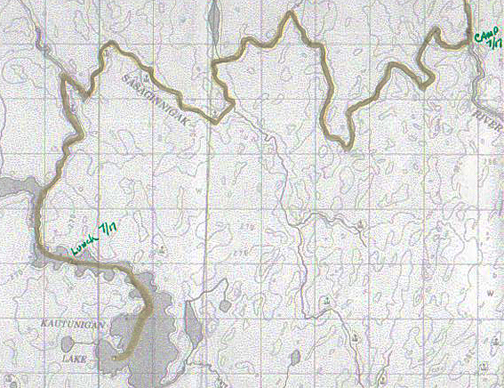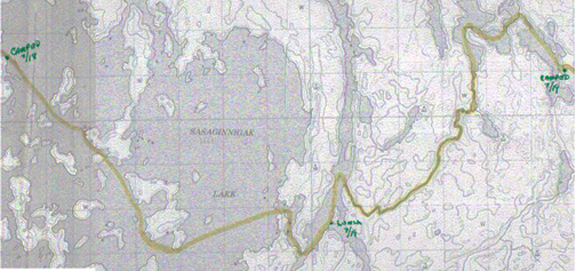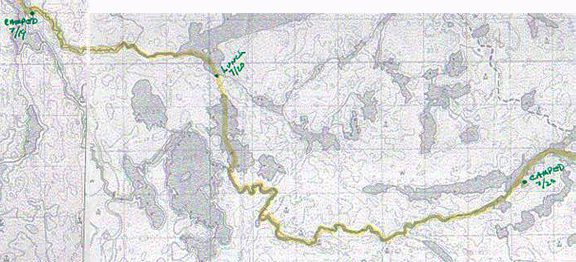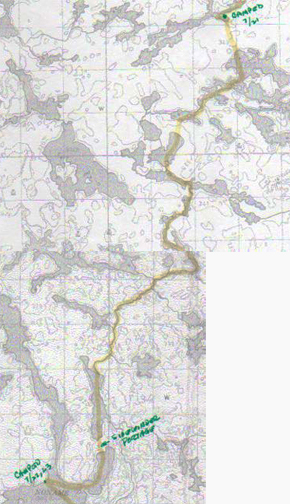

| DAY 1, JULY 17 |
|---|
 |
| We left Bissett at 10:30 and flew to Kautunigan Lake where a previous crew had left canoes. We retrieved the canoes, load the gear and were on our way as the second crew arrived. We headed north on the Bloodvein River and ate lunch before reaching the intersection with the Sasaginnigak River. Lunch was ham and cheese sandwiches and oranges. I started paddling with Trent; we had two heavy food packs in the canoe. At lunch we added a personal gear pack into the freighter canoe (ours) giving us three packs and two paddlers. The other canoes had one pack and three people. Jon Sasser paddled with me in the afternoon. The Sasaginnigak was a beautiful river that was full of atmosphere. You could feel and see voyageurs there. We did two portages and walked the canoes through a third rapid. We were able to ferry the canoes into position for the walkthrough. Campsites were few and far between, We checked a few, but they were not worth taking. About 7:30 we found a site at the intersection of the Sasaginnigak and the north branch of the river. It was situated on a pond overlooking the rapids we would portage the next day. The only problems were getting the gear up the high banks and the fact that there were only three tent sites. We solved this by Dusty sleeping with Kent and me. Supper was late and we finished doing dishes at 9:40. Still very light, but the mosquitoes were getting heavy. Distance canoed: 14.9 miles |
| DAY 2, JULY 18 |
|---|
 |
| Up at seven and on the water at nine; very good for the first day breaking camp. Paddled about 100 yards and then portaged around a rapid. We encountered problems on the day's third portage. Up to this time, all the portages had been parallel to the river. This one was across a peninsula. We did a quick check to be sure it was the portage, but we did not communicate to everyone that it did not follow the river. As a result, a couple Scouts started in the wrong direction and came back. I did the portage, but when I saw the bay on the other side, thought we were in the wrong place. Two Scouts started out parallel to the river and continued going after the trail became obscure. They realized they had lost the trail and blew their whistle once. By the time the rest of us had got back together at the portage trail head, there were not any further sounds. The three scouts at the trail head were told to wait at the end of the portage. Dusty stayed at the top of the ridge so they could not walk back up river (south) past the portage and I waited at the portage trail head. Kent then walked down river (north) and eventually found the two other scouts. Everyone was safe and we learned many valuable lessons from our mistakes. The cause was not effectively communicating the nature of the portage and the portage was not marked on all three copies of our maps. Other mistakes included not stopping when they knew they were lost and leaving their packs and life jackets at a spot and continuing to walk. Leaving their life jackets with the packs was a particula problem because their whistles were attached to the life jackets. We discussed these lessons learned over lunch and then continued. After setting up camp at a beautiful campsite on the northwest end of Sasaginnigak Lake, scouts went swimming and we relaxed. There were very dark clouds to the southeast and we used a canoe turned on its side along with our tarp to make a nice shelter. A rain and windstorm hit about three. It blew so hard that Kent and I laid in our tent with our feet in the corners to keep the tent from moving. We were camped on a large rocky point so we could not use pegs. In place of pegs, we used rocks to tie the ropes to and left the tent poles unrestrained. By 5:30, the wind had calmed and people were fishing. Jim Sussman's crew encountered the same thunderstorm. They had not reached camp and were forced to shore. While sitting under their tarp they twice felt ground electricity from lightening. The lightening strikes were not in their immediate area. It was a heavy rain with hail the size of ice cubes. Distance canoed: 6.9 miles. |
| DAY 3, JULY 19 |
|---|
 |
| Up at six and left camp at 8:30. Cloudy and foggy with calm waters. Stopped at the Lodge on Sasaginnigak Lake. We saw the Sussman crew at a camp on the east side of Sasaginnigak...it was their layover day. We stopped and visited and helped repair a broken yoke with c-clamps Kent brought. Stopped at Bow Lake for lunch at the site of an old trappers cabin. Trent found frames used to dry beaver pelts. Stopped and saw pictographs across from the river to Angela Lake. The river was fun paddling. We were able to 'paddle over' the first beaver dam but had to pull the canoes over the second. We encountered blowdown on the portage and found the best way to handle the blowdown was for one person to carry the canoe up to the fallen trees and another person take the canoe on the other side. The portage was not difficult, but did offer some challenges and new experiences. The river became very narrow (3-4 ft. wide) and full of grass. I was concerned that we might have to get out of the canoes and push them but that did not happen. Arrived at our campsite on Angela Lake about five. Everyone was tired but a good swim refreshed all. It was a good day. We had beautiful, mirror surface water to paddle on for a long time. I have never experienced that calm of water for so long. It was interesting that our campsite on Sasaginnigak Lake was open, on rocks and was full of mosquitos. By contract, the campsite on Angela was set back in the woods on caribou moss but there wasn't a tenth as many mosquitos as the night before; just the opposite of what you would expect. Distance canoed: 13.9 miles. |
| DAY 4, JULY 20 |
|---|
 |
| We were up at seven and let cam at 9:15. Headed up a creek about two miles long in a light rain. It took us all morning. Fortunately the rain did not last long. The beaver dam pullovers, portages that were steep and slippery and downed trees where we had to unload the canoes, pull the canoes over the trees and then reload were unexpected and exhausting. Ate lunch under blue skies at the start of an easy quarter mile portage about 1.7 miles from the end of the creek. We did three more portages before reaching Black Lake. The last one was great. Everyone worked together; it was like clockwork. Arrived at our campsite on Black Lake about 7:15 and everyone was very tired. Once again, a good swim refreshed us. Distance canoed: 12.0 miles. |
| DAY 5, JULY 21 |
|---|
 |
| Up at 6:30, but it was slow moving and we did not get on the water until our normal time, about 9:10. Black Lake was dead still. It was amazing the lack of wind we encountered during portaging. Paddling was through small lakes connected by portages. We did three portages and had some trouble finding the third one. The first canoes missed the takeout by about fifty yards. The trail was poorly marked and was steep in places. Arrived at our campsite across from Big Boulder Portage about 3:30. The Scouts swam, fished and relaxed. We had walleye for supper. The trip was deceivingly tough. There were not any killer portages to this point and the paddling has been without wind and waves. However, the short portages were not easy and they took their toll. The other amazing thing about the trip is the lack of people we have seen. On the first two days we saw both of our sister crews. On the second day, we saw the people at the lodge -- we saw only one other boat so far on the trip. Distance canoed: 9.3 miles. |
| DAY 6, JULY 22 |
|---|
 |
| Started getting Scouts up at 6:30 but did not get out of camp until 9:15. We paddled about 100 yards to Big Boulder Portage which was about 0.6 miles and the longest of the trip. It started well with me carrying one of the canoes. A short way in I started feeling weak and developed a case of diarrhea. Took some Pepto-Bismol and carried the canoe a little further but could not complete the portage. Dusty finished the portage. I rode duff on the next paddle and was feeling OK, but just didn't care about anything. The second portage was hard to find and was not an easy portage. I filmed the portage but did not carry any packs or canoes. I was feeling better when we stopped for lunch shortly after the portage. The next portage was essentially a bushwhack through an old burned area that had partially grown back. There were occasional cairns (we learned later that they were placed there by George's crew) but we did not find them until our third pass. The first pass by Kent and Dusty was to scout the trail. They walked to the destination lake and came back by a different route. We decided to do the portage in two passes taking the packs over first. Two Scouts stayed with the packs and we went back to get the canoes. The four different trails taken were all to the right of the original portage trail that we found on our last pass. I was feeling much better and carried a canoe without problem. By the end of the day, I was feeling better than I had for the past couple days. Our next adventure was a small creek that split a short distance from the start. Despite everyone looking for the junction so we could take the left fork, we never saw it ending up on the right fork that soon became too narrow to paddle. Once we got the canoes turned around in the swamp, we found the left fork and the paddle to the next lake went well. We canoed through a swift-water creek that had not been paddled by anyone at the base for a few years before George's and our crew did it. There were beaver dams that we had to pull over; down trees, some that you could paddle around and others that you ahd to pull over; a deadfall with strainers were we unloaded the canoes and then pulled the canoes over; and a double rapid that we walked the canoes through the first one because the portage trail was over a steep, sloping rock face and then portage the second rapid. It was wet and fun! We then entered an area where the creek was very narrow with alder growing on both sides so we were paddling under the branches. The adults wanted to camp on the small lake that the creek emptied into and the Scouts wanted to go to Noname. There was a light rain with sheet lightening in the distance. There were no decent campsites on the lake so we decided to go to Noname when the rain and lightning stopped. SIDEWINDER PORTAGE, the name we gave to the portage to Noname Lake. The first 25 yards were nice, but then I encountered two trees that were too narrow for the canoe to go through. I tried to force the canoe between them, but they would not bend so I got out from under the canoe and went back to the lake. The canoe stayed wedged between the trees. We decide to make two passes taking the packs on the first pass. We learned more that we wanted. What I encountered with the two trees was just the beginning. The portage was more like a narrow hiking trail with right angle turns, it went over rocks and through dense jack pine. On the second pass we carried the canoes with one person in the front and one in the back. By the time we reached the end of the portage, we had carried, dragged, pushed and pulled the canoes. Some turns were so sharp that the canoe had to be moved over brush piles. Other places we could turn the canoes sideways to go between trees but even then for some curves we had to be sure that the curve of the canoe was in the same directions as the curve of the trail to allow the canoes to fit between the trees. (We learned that George's crew had cut down some trees before we made the portage. Some of them went back the next day and cut more so that a canoe could be carried over the trail.) I have never done a portage like this one. We canoed under dark skies to an old trapper's cabin where we made camp. We arrived at 9:15 completing a twelve hour day of some of the most interesting paddling and portaging I had ever done...it was great. We quickly set up camp under heavy, dark clouds and cooked supper. We ate at 10:30 in the dark with lots of mosquitoes as guests (or maybe they were the hosts). The Scouts went to bed after eating and Kent, Dusty and I gave the dishes a quick rinse. They were washed in the morning. The rains came during the night but were not a problem. Distance canoed: 10.3 miles. |
| DAY 7, JULY 23 |
|---|
| Temperatures and humidities were high throughout the trip. However, on this our layover day, the temperature had cooled off enough to need a long sleeve shirt or jacket. It was overcast during the day and we had some light rain. We slept late with most of the crew getting up around nine and we had breakfast at 10:30. Dusty made cinnamon rolls later in the day. The crew spent the day fishing, reading, playing cards, sleeping, etc. Kyle caught a walleye that was about 24" long. Kent and Dusty paddled up one of the bays looking for pictographs. They found one of two sets that were supposed to be there; they saw a crew heading out. George's crew was camped across the lake. |
| DAY 8, JULY 24 |
|---|
 |
| We were up by eight and on the water at 10:15. There was a blue sky and the water was calm. We reached Scout Lake at 12:30 and were the last crew in. We spent the rest of the day resting and visiting with the other crews. The consensus was that Bissett was the best of the three Northern Tier bases. The variety of challenges, types of water and the remoteness exceeded our experienced at Atikokan and Ely. We wanted to see the Northern Lights but were afraid that we would sleep through them. Dusty had a solution. Just before going to sleep, he mixed up a full batch of bug juice. We then gathered in a circle and none could leave until all the juice was drank. We didn't have any trouble getting up to see the Northern Lights. We got up around two. The Northern Lights started out as an undulating band almost like Saturn's rings dancing across the sky. Spikes then started to appear at lower elevations in the sky and we could see them in every directions. They were not real bright, but they were beautiful. The loons were also singing. Distance canoed: 6.8 miles. |
| DAY 9, JULY 25 |
|---|
| Got up at 6:30. There was fog and mist on the lake and the loons were singing. It put a perfect cap to a fantastic trip. Paddled over to the canoe cache a little before eight. We took group picture and the first plane (Cessna) arrived at eight bringing in another crew. About an hour later the Cessna and a Beaver arrived. I flew out on the Beaver and got to the base about 10:30. We cleaned and checked in our gear and showered. |
| Date | Distance To Location (miles) |
Journal Comments | Day's Distance | Trip Distance | |
|---|---|---|---|---|---|
| Day 1 |
Float Plane Base | 0 | About 0.4 miles from base | ||
| Kautunigan Lake | 35.0 | Flew to where canoes for two crews were stashed. Started paddling about noon. Map: Sasaginnigak Lake 52/M12 |
|||
| Lunch on Bloodvein River | 2.0 | ||||
| Sasaginnigak River | 1.1 | ||||
| Portage | 1.1 | ||||
| Portage | 1.9 | ||||
| Portage | 5.1 | Walk-through | 4.0 | ||
| Campsite at Intersection of Sasaginnigak and North Sasaginnigak Rivers | 0.8 | Found a campsite at 7:30 | 13.0 | 13.0 | |
| Day 2 |
To first portage | 0.1 | Started paddling about nine | ||
| To second portage | 2.7 | ||||
| To third portage | 0.8 | Location where scouts got lost. Ate lunch at end of portage. | |||
| To pull-through | 2.0 | ||||
| Sasaginnigak Lake and campsite | 1.3 | Reached campsite on west side of lake early afternoon. | 6.9 | 19.9 | |
| Day 3 |
To lodge | 1.5 | Started paddling at 8:30. Stopped for candy and soda | ||
| To Fire Tower | 2.1 | ||||
| East shore of Sasaginnigak Lake | 1.9 | Sussman crew campsite | |||
| Bow Lake | 1.5 | ||||
| Start of creek | 0.5 | ||||
| Beaver Dam | 0.2 | Canoed over | |||
| Beaver dam | 0.2 | Pull-over | |||
| Obstruction #3 | 0.6 | Started using Map: Dogskin Lake 52/M11 | |||
| Obstruction #4 | 0.6 | ||||
| Obstruction #5 | 0.3 | ||||
| Obstruction #6 | 0.5 | ||||
| Obstruction #7 | 0.4 | ||||
| Obstruction #8 | 0.3 | ||||
| Start of creek to Angela Lake | 2.3 | ||||
| To Angela Lake campsite | 1.0 | Reached campsite at 5:00 | 13.9 | 33.8 | |
| Day 4 |
To obstruction #1 | 0.2 | Started paddling about 9:15. Obstruction was on the creek from Angela Lake to Hot Dog Lake | ||
| Obstruction #2 | 0.7 | ||||
| Obstruction #3 | 0.4 | ||||
| End of creek | 0.8 | ||||
| Hotdog Lake | 1.7 | Ate lunch here. Start of an easy portage. | |||
| End portage | 0.3 | ||||
| Start of creek | 1.2 | ||||
| Obstruction #4 | 1.5 | ||||
| Obstruction #5 | 2.7 | ||||
| Obstruction #6 | 1.4 | ||||
| Black Lake campsite | 1.2 | Reached campsite at 7:15 | 12.9 | 46.7 | |
| Day 5 |
East end of Black Lake/start of creek | 5.0 | Started paddling at 9:10. | ||
| Obstruction #1 | 0.1 | ||||
| Obstruction #2 | 0.1 | ||||
| Obstruction #3 | 0.3 | ||||
| End of unnamed lake | 1.3 | ||||
| End portage | 0.2 | Good portage trail | |||
| Leah Lake | 0.1 | Lunch | |||
| End Leah Lake | 0.8 | ||||
| End portage | 0.2 | Good portage trail | |||
| End unnamed lake | 0.2 | ||||
| End portage | 0.1 | Fair portage trail | |||
| End unnamed lake | 0.4 | ||||
| Campsite on unnamed lake near Big Boulder Portage | 0.4 | Reached campsite at 3:00 | 9.3 | 56.0 | |
| Day 6 |
Start of Big Boulder Portage to obstruction #1 | 0.1 | Started paddling about 9:15. | ||
| End of Big Boulder Portage | 0.6 | ||||
| Obstruction #1 | 1.2 | ||||
| Start of bushwhack portage | 0.3 | ||||
| End of bushwhack portage | 0.2 | ||||
| Unnamed lake | 0.1 | Lunch | |||
| Obstruction #2 | 1.1 | ||||
| Obstruction #3 | 0.2 | ||||
| Obstruction #4 | 0.4 | ||||
| Start of creek | 1.3 | Started using Map: Artery Lake 52M/6 | |||
| Lined rapids | 0.9 | ||||
| Portage | 0.2 | ||||
| Portage | 0.6 | ||||
| Fallen tree lift-over | 0.4 | ||||
| End of creek | 0.5 | ||||
| Start of Sidewinder Portage | 0.9 | ||||
| End of portage | 0.2 | ||||
| Noname Lake campsite | 1.1 | Reached campsite at 9:15. Twelve hours canoeing and portaging. | 10.3 | 66.3 | |
| Day 7 |
Lay-over day | 0.0 | 0.0 | 66.3 | Day 8 |
Beaver dam lift-over | 2.2 | Started paddling about 10:15. |
| To portage | 1.7 | ||||
| Scout Lake campsite | 2.9 | Reached campsite at 9:15 | 6.8 | 73.1 | |
| Day 9 |
Flew to float plane base in Bissett | 30.0 |